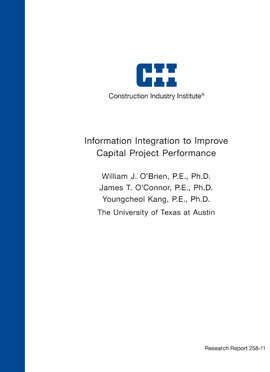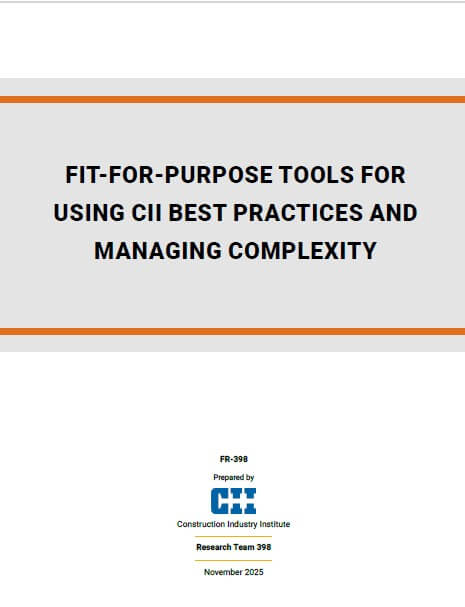
Information Integration to Improve Capital Project Performance
CII Research Team (RT) 258 was broadly chartered to help CII member companies improve their use of information integration on capital projects. Information integration is a broad topic that encompasses people, technology and work processes. RT 258 has adopted the following definition of capital project information integration: “The sharing of information among project participants to support effective execution. Information integration is achieved with systems, work processes, and organizations that support the seamless exchange of and access to data.” As such, information integration is not just “information technology” or “IT” but is about supporting business processes and transactions across project participants.
The capital projects industry has many opportunities to improve information integration performance. The literature is replete with implementation examples—for example, 3D/4D CAD implementations (Hartmann, et al., 2008, Koo and Fischer, 2000, Staub-French and Khanzode, 2007), engineering analyses support by integrated databases (Miyatake and Kangari, 1993, Ahmed, et al., 2003), lifecycle uses of integrated information (Goedert and Meadati, 2008, Eastman, et al., 2008), etc. Firms have numerous opportunities to use integrated information to improve current work processes or implement new ones. However, identifying and prioritizing information integration opportunities are challenging tasks for firms. With respect to generating ideas about what should be done, there are many sources—for example, case studies of specific successes publicized in trade journals, capabilities offered by technology vendors, grassroots ideas within the organization, etc. There are also visions for the future state of industry performance that have an associated technical development path (for example, the Capital Projects Technology Roadmap developed by FIATECH, www.fiatech.org). It is difficult for firms to systematically collect ideas from these sources and relate them to current capabilities, as well as define an investment path that makes sense in the corporate context.
As such, the research team conducted its research to both assess the current state of information integration in the capital projects industry as well as develop mechanisms to move forward. These efforts are expressed through development of a Capital Projects Information Integration Maturity Model, an Integration Opportunity Assessment Tool, a set of case studies of successful information integration, and various reviews of the literature and CII benchmarking and metrics data related to technology use and integration. The sum of this material is published in this document as well as in the associated research summary (RS 258-1) and implementation resource (IR 258-2, volumes 1 and 2). IR 258-2 volume 2 contains the set of case studies that are of interest to practitioners as well as researchers. This research report describes the overall path of the research as well as specific aspects of development and validation of the tools. It does not duplicate the implementation resource and practitioners are directed to those publications.
The topic of information integration is a rich one that proved a source of many fertile discussions and reviews within the research team. The organization of this research report reflects this richness. Rather than following a traditional outline of literature review, methodology, data and analysis chapters, this report consists of four chapters beyond this brief introduction:
- Chapter 2 provides a comprehensive review of the team’s efforts over the two year study. It describes the overall research methodology of the research team and details links between the various activities of the team.
- Chapter 3 describes the development and application (validation) of the Capital Projects Information Integration Maturity Model. The maturity model exists in two forms: First, a general maturity model, which is intended to broadly capture the state of the industry with respect to work processes and associated investments in technologies and people. Second, a highly detailed maturity model across eight capital project functions that builds from the general model to help firms assess their capabilities within these common functions, as well as identify specific opportunities for improvement. The maturity model is compared to industry benchmarking data and applied to several case studies of information integration success undertaken by CII member companies.
- Chapter 4 outlines the Information Integration Opportunity Assessment Tool (IOP Tool), which can help firms better evaluate implementation drivers and hindrances that may affect a specific tool. The tool walks users through 37 benefit driver questions and implementation hindrance questions and provides a score that that summarizes relative driver/hindrance weights. The score is placed on a grid Companion detail about the tool is provided in IR 258-2 volume 1. This chapter focuses on development efforts and validation tool by application to 16 test cases independently identified as implementation successes/limited successes.
- Chapter 5 further analyzes the data from the 16 test cases used to validate the IOP Tool to better characterize which drivers/hindrances actively affect integration implementation efforts. The tool compares importance scores determined by the research team with rankings from assessments from the 16 cases. These allow comprehensive review of which drivers/hindrances are most important and most consistently experienced by industry.
Chapters three through five are semi-independent and describe different tools and analyses that contribute to the academic in industry understanding of information integration. Literature review and conclusions are contained with each chapter. Collectively, the work advances the state of knowledge in significant ways, adding considerable detail to the literature.



